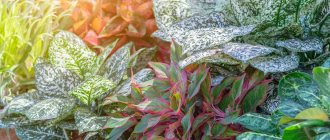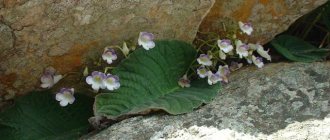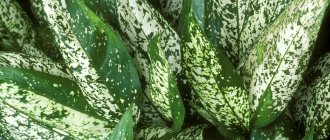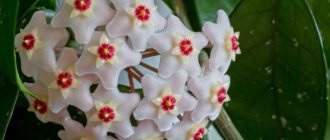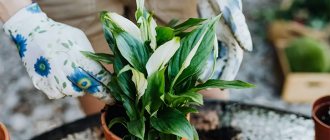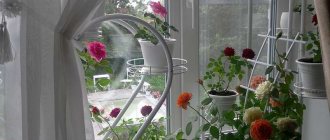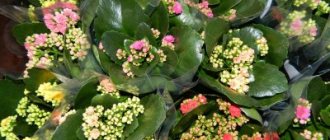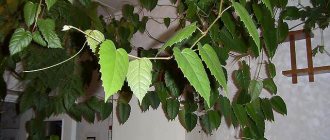This ornamental plant resembles Dieffenbachia in appearance, but catches the eye with its majestic leaves, decorated with elegant patterns. Its magnificent, colorful, variegated leaves effectively decorate apartments and semi-shaded shelves. It looks fantastic in interiors, grows quickly and does not require special care. It is enough to provide her with a suitable position and take care of the correct temperature and moisture. Find out how to properly grow aglaonema - care at home, how to transplant and propagate, what conditions it needs.
Origin and appearance of aglaonema
Aglaonema is a perennial plant from Southeast Asia, it belongs to the genus of evergreen herbs and shrubs of the Araceae family. Aglaonema is widespread in India, China, Cambodia, Laos, Thailand, Vietnam, and Malaysia.
The first description of Aglaonema appeared in 1704. It was made by a Jesuit priest who lived in the Philippines. The original name Dracunculus did not stick, and in 1829 the plant received the name by which it is still known today - aglaonema - from the Greek words aglos - bright and nema - thread. The flower owes this name to the Austrian botanist Heinrich Wilhelm Schott, who devoted a lot of time to the study of aroids.
Aglaonema - decoration of any interior
In appearance, Aglaonema is very similar to Dieffenbachia, and this is not surprising, since they are close relatives.
Aglaonema is a small decorative foliage plant with a height of 30 to 80 cm with an erect trunk. However, it becomes noticeable only in mature plants, as the leaves die. In some species the trunk branches at the base. The leaves are on short or long petioles, dense, leathery, large. The shape of the leaves varies from elongated to broad oval. The midrib is depressed and clearly stands out on the bottom of the leaf. The leaves can be a variety of shades of green, depending on the variety, and are covered with silver, white, yellow and pink spots and veins. There are varieties with leaves of red shades .
The inflorescence of Aglaonema is a spadix with a pale green veil. 1 to 3 inflorescences develop in the axils of the upper leaves. The fruits are bright red, sometimes white, berries, several on the cob. They mature within 6–8 months.
Each Aglaonema berry contains one seed.
In nature, the habitat of Aglaonema is tropical and deciduous forests, wet plains, river banks and marshy peat deposits. Aglaonema is very hardy, able to grow in poor soils and tolerate lack of light. Thanks to these qualities, Aglaonema is considered an ideal plant for growing at home and in the office.
Aglaonema juice contains substances that irritate the skin. The seeds of the plant are also poisonous.
Harm
Sometimes aglaonema berries or leaves cause skin irritation. As a rule, people with a tendency to allergies or hypersensitivity are susceptible to this. When separating petioles for replanting and propagation, be careful. It is better to carry out these actions with gloves, since the juice from the stems and leaves is quite poisonous. It may cause swelling in people prone to allergic reactions. Do not allow this juice to get into your eyes or mucous membranes; conjunctivitis or severe irritation may occur.
Popular varieties with different leaf colors
This plant appeared in greenhouses and homes in Europe in 1885. Books on floriculture of those times described the difficulties of maintaining the plant - it required high humidity and regular spraying. But the interest in aglaonema was so great that a large number of unpretentious hybrid varieties were subsequently developed.
There are about 50 species of aglaonema in nature. And the number of hybrids bred today is approaching 500.
Silver Queen . One of the most common Aglaonema hybrids, it was bred in the 60s of the 20th century. The length of the leaves reaches 15 cm, and the width is 8 cm. The color of the leaves is smoky-silver with a few green splashes. Very easy to care for, prefers partial shade. The bush usually reaches 70–80 cm in height.
Silver King . Just as easy to care for as the variety described above, but shorter. The color of the leaves and cuttings is silver-gray.
Crete . The variety belongs to the group of red aglaonemas. The plant is slow growing. The color of the leaves changes with age. If young leaves are completely red, then as they grow, spots appear on them, ranging in color from rich green to olive. This variety is very demanding on lighting. In a darkened room, the leaves lose their bright color and glossy shine. It reaches a height of 30–40 cm.
Aglaonema modest . The variety has good shade tolerance. The leaves are rich green in color, about 20 cm long. The plant reaches a height of 50 cm.
Treiba . It is considered the most unpretentious variety. A low bush with narrow leaves about 15 cm in length, covered with a silver-green pattern.
Maria . The most popular variety of aglaonema, which is more than 50 years old. A very shade-tolerant plant, it can grow even in rooms with artificial lighting. The lush bush reaches a height of 50 cm. The leaves are ellipsoidal, green with silver spots.
Aglaonema curly. This is a large - up to 120 cm in height - plant with a vertical stem. The leaf blade is semicircular, up to 30 cm long and 16 cm wide. The color of the leaves is silver-matte, with the exception of the middle and edge of the leaf blade.
Siam Aurora . Another representative of the red group. Unpretentious, grows quickly. With additional lighting, the leaves become brightly colored. In the sun it “fades”: red colors darken, and green colors become yellow.
Photo gallery: Crete, Maria, Treiba and other popular varieties of aglaonema
Aglaonema Siam Aurora
Aglaonema curly
Aglaonema Maria
Aglaonema Treiba
Aglaonema Modest
Aglaonema Crete
Aglaonema Silver King
Aglaonema Silver Queen
Features of culture
@ dropStock stock.adobe.com Aglaonema cuttings in a container of water
Aglaonema is an evergreen herbaceous plant that has a short, erect stem. There are certain varieties that have a predisposition to branch at the base. The stem itself is present only in mature plants; its formation is ensured by the falling of the lower leaves. The color of the foliage depends on the variety; the shape can be ovoid or lanceolate. The leaves are attached to the trunk using petioles, which can be short or elongated.
The edge of the leaf is solid, the plate is patterned with a depressed midrib, which appears convex on the reverse side. At the top of the aglaonema, cobs with a white cover are formed from the leaf axils - this is the inflorescence of the plant. In the case of pollination, a fruit ripens from the peduncle, which is a fleshy berry containing 1 seed. The berry has a bright, red or orange color. The ripening process is long, taking 6-8 months.
Care
Place
Do not place aglaonema in direct sunlight, as this may result in leaf burn. Partial shade is ideal. For varieties with variegated leaf colors, bright, diffused light is preferable.
In winter, it is worth additionally highlighting the plants, because aglaonema needs light for 12–15 hours during the day.
The place where aglaonema grows must be protected from drafts and tobacco smoke. The plant loves clean air. Aglaonema will feel good in a ventilated room, but it is better not to place it in the kitchen.
Watering and fertilizing
For the good development of aglaonema, the correct watering and feeding regime is important. This plant is moisture-loving, so in spring and summer we generously water our pet. But most importantly, don’t overfill it. Do not allow water to stagnate in the pan. After watering, the water should be completely absorbed into the soil. The next watering is carried out when the top layer of soil is slightly dry . You can understand when the time for watering has come by probing the soil to a depth of 5 cm. If the soil is dry, water it; if it is wet, postpone watering. In the fall, before the onset of cold weather, we water abundantly, but as the temperature drops, we reduce watering. In winter, watering is carried out after the earthen clod dries.
Water for irrigation is used soft, room temperature, settled. In winter, it is better to heat the water slightly.
During the growing season from March to August, fertilizing is done once every two weeks. Mineral fertilizers alternate with organic ones. In autumn, the growth of aglaonema slows down and feeding is reduced. In winter there is a period of rest - fertilizing is not needed during this period.
Aglaonema does not like lime fertilizers.
Differences in care during flowering and dormancy
Under natural conditions, aglaonema blooms from June to August. Making aglaonema bloom is very simple. To do this, you need to create good conditions for it: a wide and shallow pot, regular spraying and watering, a comfortable temperature in the room without sudden fluctuations.
To speed up flowering, you can include bone meal in the fertilizing.
The aglaonema flower is not of particular decorative value and many gardeners remove it, especially on young plants. You can leave the peduncle: sometimes self-pollination occurs and fruits are set. If this does not happen, then after the flower dries, it must be carefully cut off. But if you prefer the decorative qualities of foliage, then it is best to remove the flowers: flowering contributes to the shrinkage of the leaves.
Aglaonema flowers are not particularly decorative
Like most house plants, the dormant period for aglaonema occurs in winter . During this period, the active growth of the plant slows down. The periods between watering increase, feeding stops altogether. We maintain high humidity and spray the plant with slightly warm water.
If the air temperature in the room does not drop below 20 degrees, aglaonema may not go into “winter mode”.
Table: seasonal care for aglaonema at home
| Season | Watering | Lighting | Humidity | Air temperature | Top dressing |
| Spring |
|
| It is necessary to regularly spray and wash the plant. | 20–25 degrees. | Lime-free complex fertilizers for indoor plants - every 2 weeks. |
| Summer | |||||
| Autumn | Carefully spray the flower with warm water. |
| Feeding is reduced. | ||
| Winter |
|
| The flower is not fed. |
Aglaonema leaves should never be treated with sprays to add shine. It is enough to simply wash them regularly with water at room temperature.
Transfer
Aglaonema grows slowly. For full growth and splendor of the bush, tightness is extremely necessary, which is as close as possible to natural conditions. Taking this into account, adult specimens are replanted no more than once every four or even five years. Young plants are replanted every year.
When drawing up the timing of the procedure, they are guided not only by the age of the flower
You should also pay attention to the condition of the earthen coma. The stronger it is entwined with roots, the faster the time for transplantation will come.
Optimal seasons are spring or summer.
The root system of the plant is fibrous and superficial. This means that a deep pot cannot be used. It is better to choose a wide and shallow option. In general, when determining the volume, it is taken into account that a quarter of it is allocated for drainage.
Important to remember! Newly acquired Aglaonema should not be replanted earlier than after two or three weeks.
Interesting! It is practiced to grow Aglaonema without any soil at all. A special nutrient solution is sufficient.
How to transplant a flower correctly
Young aglaonema is replanted annually in the spring. An adult plant feels great in a cramped pot when the root system is limited, so replanting is done every 2–5 years, but as necessary, replace the top layer of soil with a new one. To do this, carefully remove about 2 centimeters of old soil and add new soil.
The ideal soil for planting would be a mixture of 3 parts leaf soil, 2 parts peat, 1 part humus and 1 part sand. Aglaonema prefers loose, uncrowded soil with good air and water permeability.
We pay special attention to the planting pot. Aglaonema has a superficial and fibrous root system, so a deep pot is undesirable. We will give preference to a wide one, taking into account the appearance of new young plants, and a shallow one. Aglaonema grows better if its roots are limited to a small space. When choosing the size of a planting pot, keep in mind that approximately a quarter of its volume will be taken up by drainage.
- Pour a layer of drainage into the selected pot: small pebbles, broken shards or expanded clay.
Drainage is necessary to avoid stagnation of water in the root system.
- Fill the prepared soil to approximately half the volume.
- Carefully straightening the roots, place the aglaonema in the center of the pot.
- We fill up the soil. If the plant is young, then it does not need to be buried. An old plant with a bare trunk can be slightly buried.
- After planting, water the aglaonema abundantly.
Store-bought aglaonema is not immediately replanted. She is given 2 to 3 weeks to adapt, and then transplanted, observing all the rules listed above .
Aglaonema also grows well in a nutrient solution without soil - hydroponics.
Independent propagation of aglaonemas
Aglaonema can be propagated using traditional methods: cuttings, division or sowing seeds.
Seed propagation method
Seed propagation makes it possible to obtain a large amount of planting material in a short time. But, they will grow somewhat slower than those obtained by cuttings. The seeds can be collected from the berries of the house plant; they should be deep red in color and easily separated from the cob. As a rule, they have a very high germination rate.
Each berry has one seed, so Aglaonema does not require artificial pollination.
The seeds should be removed immediately after picking the berries. They are washed and dried well. It is advisable to plant them immediately after this, since their germination rate decreases sharply during storage.
Reproduction by dividing the bush
Dividing an aglaonema bush is the easiest method of propagation, taking the least amount of time. It is best to do this during May. Young plants are separated from the mother plant. For planting, you need to choose seedlings with a well-developed root system and healthy leaves. They are planted in individual pots with pre-prepared soil of the required composition and covered with glass containers.
During rooting, young plants require abundant watering and regular spraying.
The room temperature must be maintained at about twenty degrees. Rooted plants are cared for in the same way as mature plants.
Propagation of aglaonema by cuttings
Cuttings are carried out using apical or lateral shoots. You can also propagate Aglaonema from stem sections. For rooting, you can use light soil, sphagnum moss, sand, perlite or plain water.
Rooting occurs best in light soils in a warm, well-lit room. The cuttings are separated from the main plant, the places of all cuts are sprinkled with crushed coal and dried.
Next, they are placed in the soil mixture, watered and covered with plastic film. Under favorable conditions, roots form within a month. After this, the young shoots are transplanted into separate pots.
If a large amount of planting material is required, you can take the trunk of an adult plant and divide it with a sharp knife into pieces five centimeters long. Then they are placed horizontally in seedling boxes on light soil, lightly sprinkled on top, moistened and covered with polyethylene film. It must be removed regularly for ventilation and watering. You can use mini-greenhouses.
Aglaonemas obtained from trunk segments that have at least a few leaves will take root faster and grow better. Leafless sections take longer to take root.
Droplets, brown spots and other problems
Table: errors in care and their elimination
| Problem | Cause | Elimination |
| The leaves dry out and become brittle. | The room is too dry and hot. | Transfer the plant to a ventilated area, wipe the leaves with a damp cloth, and spray. |
| The edges of the leaves began to turn yellow. | Watering is done with hard chlorinated water. | Leave the water for at least a day before watering. |
| The edges of the leaves have become limp. | Excessive or insufficient watering. | Dig the soil in the pot to see if the soil is dry enough before the next watering. |
| Droplets appeared on the leaves. |
|
|
| Leaves lose color and yellow spots appear. | Possible burns from direct sunlight. | Remove aglaonema from direct sun. |
| The leaves began to shrink. | Most likely a lack of nutrients. | Feed the plant. |
| Curled leaves with brown edges. | Too cold air or drafts. | Remove the aglaonema to a warmer room without drafts. |
Table: diseases and pests of aglaonema
| Problem | Symptoms | Control and prevention |
| Gray rot | Gray, sometimes brown spots appear on the leaves and stem, soft to the touch. They spread quickly throughout the plant. |
|
| Rust | A fungal disease in which orange “velvet” pads appear on the underside of the leaf and golden spots on the top. | Remove the affected parts of the flower and pollinate the plant with ground sulfur. |
| Mealybug | The leaves become distorted, dry out and fall off. White, fluffy, cotton-ball-like pests can be seen on stems, leaves and in their axils. | Actellik, Fitoverm, Fazol - apply strictly according to the instructions, using protective measures (gloves, gauze bandage). |
| Aphid | The leaves curl, dry out, and fall off. Aphids are located on the lower part of the leaf and are clearly visible. |
|
| Spider mite | The lower part of the leaf is covered with thin threads resembling a cobweb with whitish dots. The mite sucks the juices from the plant. |
|
| Thrips | Dry spots or streaks appear on the leaves. The leaf becomes deformed and falls off. | Remove the top layer of soil to a depth of 3–5 cm, wipe the aglaonema with a soap solution. After 4–5 hours, spray with Fitoverm. |
| Whitefly | The lower leaves become covered with a sticky coating. Small white insects living under the leaves are visually noticeable. |
|
| Shchitovka | Brown tubercles on the leaves and stem of aglaonema. Scale insect larvae can attract sooty fungus. | Scale insects are removed mechanically using a damp cloth soaked in a weak soap solution. Every 3-4 days the procedure must be repeated until the scale insects completely disappear. |
Difficulties encountered during cultivation
Growing mistakes made by gardeners always affect the appearance of plants. If you examine them regularly, you can provide timely assistance.
Here is a list of frequently encountered points:
- If the room is too dry, the leaves wrinkle, dry out, and become brittle. Their edges turn brown. They also curl when exposed to drafts or cold air.
- When burned by sunlight, white-yellow spots appear on the leaf blades. You need to remove the plant to another place. After some time, spray.
- Watering with hard and cold water leads to slower growth of the flower and the appearance of brown spots on the edges of the leaves. To reduce water hardness, gardeners use citric acid.
- Leaves become smaller when there is a deficiency in fertilizing.
Spots on leaves caused by sunlight
Interesting to know! Sometimes droplets are visible on the leaves. This is how the plant tries to get rid of excess moisture or excess nitrogen.
How can aglaonema reproduce?
Reproduction of aglaonema does not present any particular difficulties. There are three ways: seeds, cuttings and root division. Aglaonema is not propagated by leaves.
Seeds
This method is suitable for those gardeners who love surprises. The fact is that plants grown from seeds often do not resemble their parents. You can collect seeds only when they are easily separated from the fruit at the slightest touch. If you need to make an effort when extracting the seeds, it means they are not yet ripe . Seeds must be planted immediately.
The longer you wait to plant the collected seeds, the less likely they are to germinate.
Process description:
- A mixture of peat and river sand in equal proportions is poured into wide flat pots or boxes; sphagnum moss is also suitable.
- The seeds are not deeply buried - a maximum of 1.5 centimeters into moist soil.
- The planting container is covered with polyethylene or glass.
- Every 2-3 days the soil is sprayed with a spray bottle.
- Under favorable conditions, the first shoots appear after 3 months.
- After a pair of true leaves appear, the aglaonema can be transplanted into a separate pot.
Plants grown from seed are usually vigorous but grow slowly. Varietal characteristics are almost never preserved. This is especially true for highly decorative varieties bred through selection.
Cuttings
As cuttings, you can use apical, lateral shoots of aglaonema or parts of the bare trunk of an adult plant that have growing points . The length of the cutting should be at least 3–5 centimeters, and the presence of at least one leaf guarantees almost 100% rooting.
Rooting parts of the trunk can be done all year round, but it is best to do this in March-April.
- Powder the chopped parts of the trunk with crushed activated carbon and dry for a day.
- We lightly press a piece of the trunk into the wet substrate, if it is small, and if the piece is larger, we deepen it vertically to the growth point.
- Cover with a plastic bag and place in a warm, bright place.
- The temperature should be from +24 to +26 degrees. You need to ventilate the cuttings once a day, slightly lifting the bag. Keep the soil moist.
- In a month, roots will appear.
Rooting part of the trunk is a fairly effective way to propagate aglaonema
Rooting of apical or lateral shoots occurs as follows:
- We cut off the shoots and tie the leaves on them into a bundle to reduce moisture evaporation.
- We dip them for a few minutes in a solution of Epin or Zircon for better root formation (you don’t have to do this, aglaonema usually takes root well without this procedure).
- Sprinkle the sections with crushed activated carbon and dry for 8 hours.
- Prepare the pot: pour drainage and soil in half with sand. We moisturize well.
- Using a pencil or stick, make a hole in the ground.
- We plant the cutting to the base of the leaf, compacting the soil around it.
- Using a frame and cellophane we make a greenhouse.
- Place in a warm, bright place. Ventilate periodically.
- Don't forget to moisten the soil as it dries.
- In a month, the aglaonema will have a root system.
Rooting apical and lateral shoots is one of the most popular methods of propagating aglaonema
You can root apical cuttings and side shoots simply in water with the addition of growth stimulants (Zircon, Epin). Dip the cutting into the solution and place it in a warm and bright place. The water needs to be changed every 3-4 days. In direct sunlight the water may turn green.
Dividing rhizomes
An adult, heavily grown plant, which is divided into several bushes, is best suited for this method.
- Remove the aglaonema from the pot.
- Shake off excess soil and wash the roots in water.
- Using a sharp knife or scissors, separate the young shoots with a formed root system.
The plant to be separated must have at least 3 leaves.
- Sprinkle the cut areas with activated carbon, crushed into powder.
- Immediately plant the separated shoot in a pot prepared in advance and water well.
- Place in a warm place for a week. Spray periodically.
- When a young leaf appears on the aglaonema, which indicates normal rooting, place the pot with the plant in a permanent place.
Dividing the rhizome of aglaonema during transplantation is the easiest method of propagation
Secrets of successful plant propagation
You can propagate a houseplant in several ways:
- cuttings;
- sowing seeds;
- dividing an adult plant (bush).
Now let's look in more detail at the description of each method. All the proposed options are not too complicated even for a novice gardener, but the choice of the most appropriate method depends on everyone’s personal preferences.
Cuttings
Plant propagation by cuttings occurs quite quickly and, most importantly, productively. To obtain material, shoots from the top and sides are used. Sometimes they even use sections from the main tall trunk (if there is one). Cuttings with foliage are placed in prepared soil and watered abundantly. To ensure rooting occurs faster, the sprouts can be covered with a jar or cut-off plastic bottle. The container with the planted material is placed in a warm, bright place with diffused sunlight. After just a few weeks to a month, the first roots should appear.
Aglonema also reproduces quite well by rooting the trunk. The photo shows how to correctly position a section of the trunk of an adult plant, and how young shoots appear.
Seeds
When choosing to sow aglaonema with seeds, you need to be prepared for the fact that the grown plant will most likely differ from the mother plant (the seeds do not retain the characteristics of the parent flower).
Description of the sowing process:
- Seeds are removed from a fully ripe fruit and sown as early as possible.
- Seeds are placed in prepared soil (mixed peat and fine river sand with the addition of moss). Seed material should not be planted too deep; it will be enough to deepen it by 1-1.5 cm.
- Moisten the surface well and cover with glass (plastic bag).
- Several times a week it is worth opening the surface of the pot for ventilation and watering (spraying).
With proper care, the first shoots will appear within a few months. A young plant can be replanted to a permanent place only after a pair of true leaves appear.
Plants grown from seeds grow much longer than those propagated by other means. But such shoots are distinguished by their endurance and resistance to pests and diseases.
Division
By dividing the rhizomes, you can propagate an adult (very overgrown) plant. This will make the flower grow and bloom even better in the future.
The division process is as follows:
- Carefully remove the flower from the pot (turn it over and tap the bottom with your palm).
- Wash off the soil from the rhizomes under a gentle stream of water.
- Using large scissors or a knife, divide the plant into 2-3 parts. Make sure that the part to be separated has at least 3 leaves.
- Sprinkle the cut areas with activated carbon powder.
- Then plant parts of the plant in pots and water generously with settled water at room temperature.
Within a few weeks, or even earlier, young leaves will appear on the aglaonema. This will be a kind of signal that the plant has taken root.
Reviews
A relative of Dieffenbachia, the plant Aglaonema, came to me several years ago. <…> Over the course of several years, the plant grew longer and the color became less variegated, so I grew a new one from a tip cutting, which was not difficult to do. I like this indoor flower because it does not require special care, effectively purifies indoor air, and reduces the content of harmful substances that enter the apartment.
tamarav https://spasibovsem.ru/responses/rodstvennitsa-diffenbahii.html
I really like Aglaonemas for their unpretentiousness and variety of colors. For about two years I tried to root several different varieties. Unfortunately, they didn't want to grow. She fed, sprayed, tried to find the most suitable place. Everything was useless. I decided to tackle the root system. For six months I watered it with Ribav and Zircon (to form a root system). The result was not long in coming.
irulchik https://myfl.ru/category/nazvanie-rasteniya/aglaonema
My aglaonemas appeared not so long ago, but the red color is completely preserved. I think that in good lighting conditions it will not disappear. Shrinking of leaves, disappearance of variegation - these are similar to signs of insufficient lighting. In my opinion, red aglaonema, like its less colorful relatives, is a very unpretentious plant. It has a lot of advantages - it tolerates overdrying, low humidity, heat and at the same time does not dry out the tips of the leaves and retains an attractive appearance. In general, I am a fan of this plant, like all others with beautiful leaves.
Vanda https://flo.com.ua/forum/viewtopic.php?t=17400
Exercise caution
When working with the indoor plant Aglaonema Variable, Mix or Red, as well as with other species, you must follow safety rules. When replanting, loosening and other activities carried out with the flower, you need to wear gloves on your hands. The fact is that the sap of the plant is very caustic and, if it gets on the skin, can leave a burn. Never rub your eyes after working with aglonema without washing your hands. Wash your hands up to the elbows well with soap as soon as you finish working with the plant.
This is an amazing and beautiful flower - aglaonema! Caring for it at home will only bring you joy if you follow the prescribed rules, because thanks to this the plant will be healthy and beautiful!
Diseases
Aglaonema grows naturally in humid conditions. Dry air makes a houseplant more susceptible to spider mites. In some cases, the plant suffers from mealyworms. These pests can be removed in different ways, for example, aphids can be removed using a hard jet of water. Biological or chemical control is recommended for spider mites and other lice.
Palm tree conditions
Like other tropical crops, aglaonema loves warmth and moisture. Direct rays of the sun and drafts can be detrimental to it. And yet, when choosing a flower, take into account the individual characteristics of each variety. For example, the shiny aglaonema requires a lot of space, so it is best to keep it alone on the windowsill.
Lighting recommendations
Ideal conditions are diffused light and a shady place. If it's a window, let it face north, west or east. You can place the pot in the center of the room. Aglaonema will need artificial lighting.
Attention! These tips are more relevant for variegated varieties. Varieties with bright green leaves can be placed in almost any environment
Optimal temperature
In the hot season, the room thermometer should fluctuate at +22...+26 °C. Changes of more than 7 °C can kill aglaonema. Other risk factors are an increase in temperature to +30 °C or a decrease to +15 °C. In winter, maintain from +20 to +22 °C.
Air humidity
The task of a caring gardener is to create an atmosphere at home that is close to the natural one for the flower. You will have to periodically irrigate the aglaonema with a spray bottle. You can use other methods to increase the humidity in a room. For example, put moistened pebbles or expanded clay in a tray.
Keep in mind. In cool conditions and during the dormant period, the plant is not sprayed.
